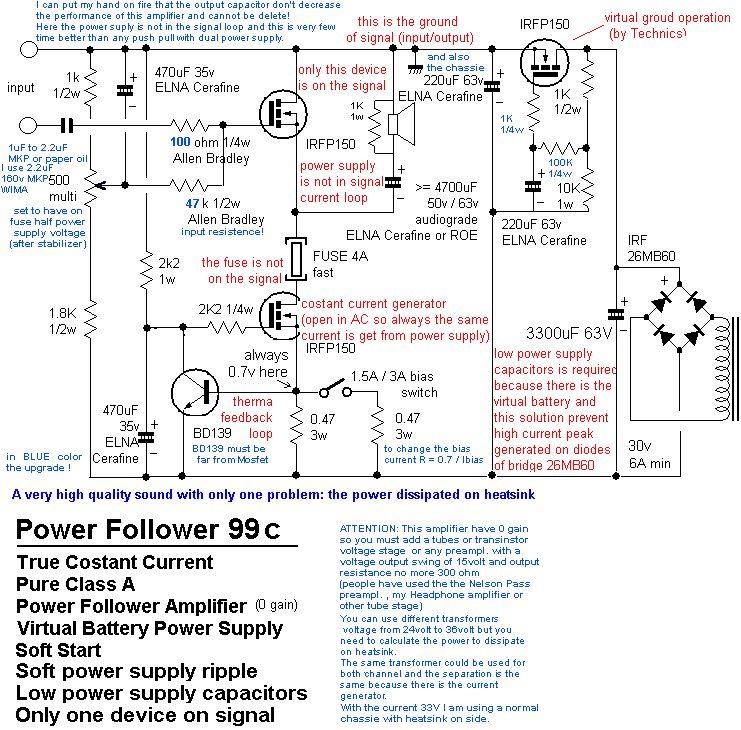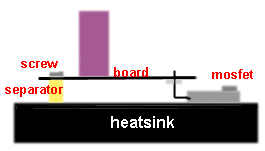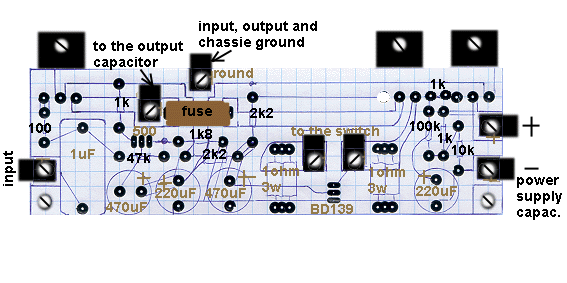| |
|
|
|
|
|
|
|
|
|
|
|
|
|
|
 |
|
 |
 |
|
||||||||||
|
|
|
|
|
|
|
|
|
|
|
|
||||
|
|
|
|
|
|
|
|
Power Follower 99 by Andrea Ciuffoli |
|
|
It seems a silly and common circuit but it has got great differences from any other similar design, that's why this is unique. We have a typical source follower (as an emitter follower but with a Mosfet) woking in pure class A with a current generator. Please note that this circuit works only in class A, so it requires enough bias current for the requested output power. The current generator is locked with a DC feedback through a BD139 in order to prevent any thermal effect (avalanche) on quiescent current. The first feature making the difference in the sonic results is the negative power supply and the signal ground tied to the drain of source follower. With this layout we achieve: The second feature is in the big concern in the power supply design. Onto a capacitive-input power supply, where there is a diode bridge connected to a big capacitor, very high current peak are generated on the diodes. Those peaks generate residuals all over the amplifier power band. So, this circuit adopt a little capacitor after the bridge. The value of this component has been computed with a precise analysis and simulation made with Spice3f4 (electrical simulation software for UNIX).
This stage is followed by a MOSFET voltage regulator, featuring a very low frequency CR filter (220uF/100Kohm) which is based on the Virtual Battery Operation, invented by Technics (something good can be found in the consumer world, too) Also the components used in this stage has been simulated and optimized for a 3A quiescent current and with a capacitor value of 3300uF. After the regulator there is a little capacitor that could appear 'ridicolous' actually it's enougth because this should not support any current-peak request: in any situation the current requested by the amplifier is costant. The 500 Ohm precision trimmer should be set to balance the output fuse voltage to 1/2 of the regulator output. This single trim could be done after the switch-on, because it just optimizes the output swing to the maximum available.The quiescent current is set by the resistence on current generator source pin, and can be changed with the simple formula Iq = 0.7 / R where 0.7 is the BD139 Vbe. I have implemented on-board a connection for a switch to modify the bias current (2 values) because, since sometimes I listen at music with a low spl in this way I can save power dissipation. The power supply transformer can be used with different voltages and currents, from 24V to 33V but with 250 VA min. per channel otherwise you have to reduce the bias current. With a bias current of 3A you can get about 30 Wrms @ 6 Ohm load. The power can be increased with the unique drawback of the dissipated power (heat)! In fact this is a single ended class A, therefore the theoretical efficiency is 25%, with 100 W dissipated power, we have only 25 W available to the load. I have implemented this circuit in a standard rack with side heatsinks, whose dimensions are: 30x42x12 cm. I would suggest to increase its dimensions to 30x42x16 cm, or to choose for a different mechanical layout like a forced air flow tunnel. Please note the pervasive ELNA Cerafine usage, wich I like a lot. I would say that the MKP/Paper in oil input cap, the input bypass (470 uF) and the output cap are significant over the sound quality. Concerning the others ROE, SPRAGUE, MALLORY o SIEMENS computer grade are OK. Concerning the output capacitor, it is important to understand that such a component is a need, and does not worsten the device quality. Again note that a dual rail with a push-pull output stage does NOT solve the problem! The presented topology, has NO gain (actually it looses something) and should be preceded by voltage gain stage, with an output swing not lower than 10Vrms and Rout < 1000Ohm. The input impedance is 47KOhm/1450pF and its resistive value can be adjusted by a pretty wide range, just using a different input resistance. The input capacitance, 1450pF, seems to be very high. Please note that a gain stage with a 1000 Ohm output resistance gives a > 100 KHz cutoff frequency. My current setup is a vacuum state preamplifier, made by a SE 5842 resistively load, followed by an E182CC connected as a Cathode Follower usable to drive also a Sennheiser 580 Hearphone. The output device, IRFP150, can be substituted by their TO3 equivalents or by other similar MOSFETs like IRF250, IRFP250, IRF240, IRFP240, with a minimal impact.
It is possible to wire the circuit without a PCB. In order to reduce the circuit complexity to be handled by this kind of implementation it is possible to leave the regulator, obviously increasing the Filter Capacitor from 3300 uF to a minimum of 22 mF.
Thanks to Nelson Pass and the Electronics World magazine who drove me to a SE MOSFET pure class A configuration, Elmar Tielke (Dortmund - Germany) who made me aware the initial version of the amplifier was not taking a constant current from the power supply and Francesco Pintavalle, for his support on theoretical aspects, and for talking and designing audio circuits with me everyday since many years. If you are interested in contacting me, please feel free to surf on: http://www.geocities.com/ResearchTriangle/8231/ Ciao, have a nice listening hours. Andrea. |
|



